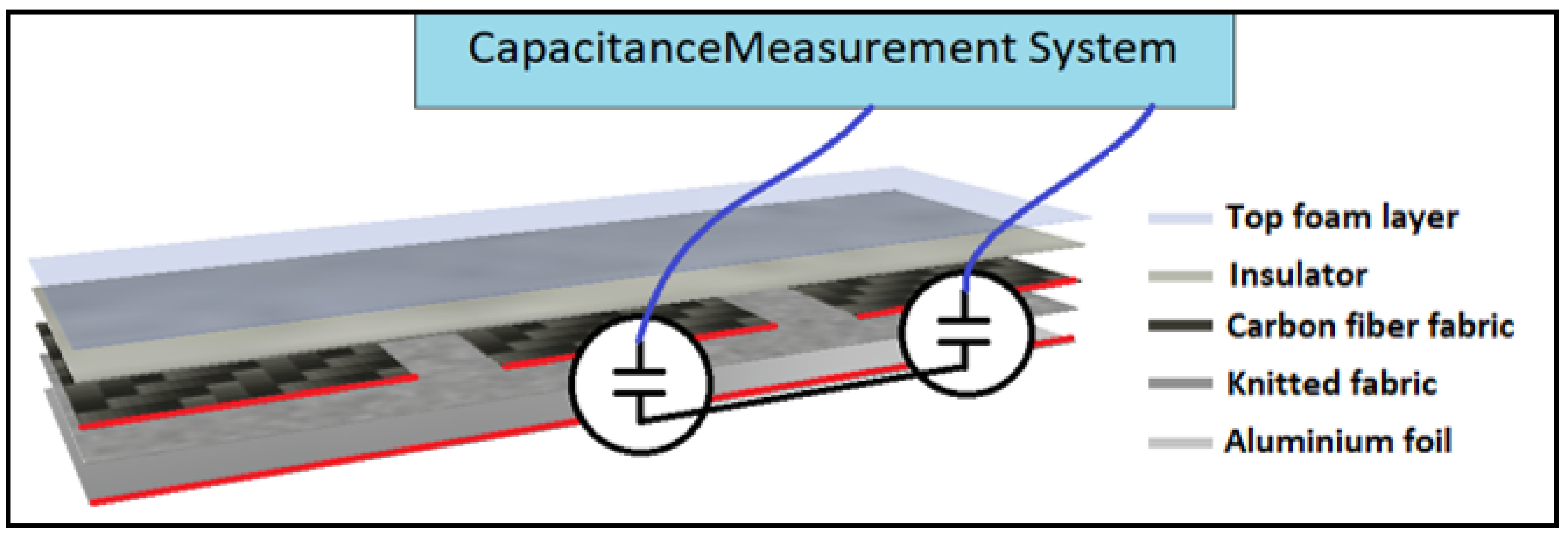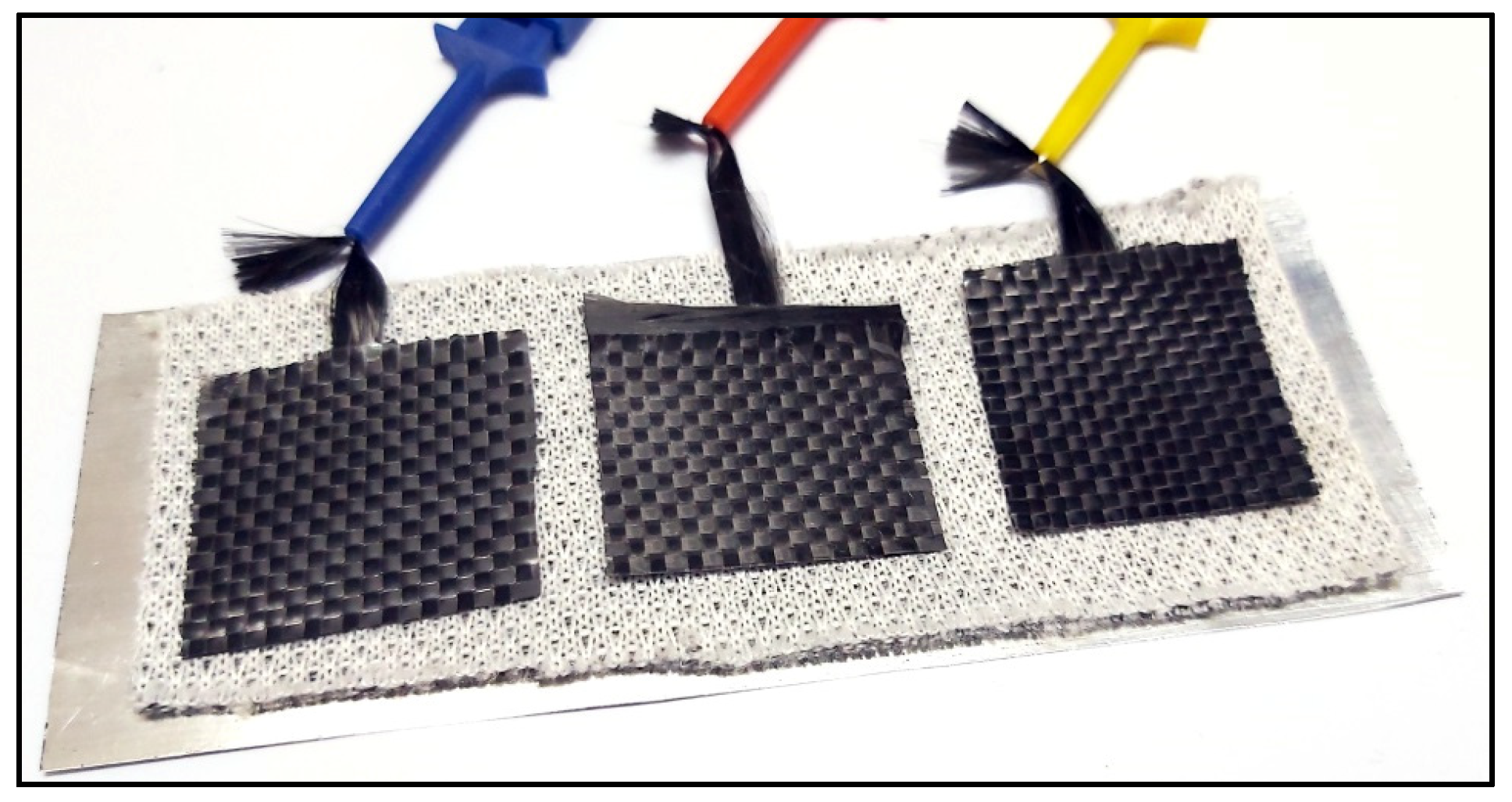A Single-Electrode, Textile-Based, Flexible Capacitive Pressure Sensor Array †
Abstract
1. Introduction
2. Materials and Methods
3. Results
4. Conclusions
Author Contributions
Funding
Institutional Review Board Statement
Informed Consent Statement
Data Availability Statement
Conflicts of Interest
References
- Tao, J.; Dong, M.; Li, L.; Wang, C.; Li, J.; Liu, Y.; Bao, R.; Pan, C. Real-time pressure mapping smart insole system based on a controllable vertical pore dielectric layer. Microsyst. Nanoeng. 2020, 6, 62. [Google Scholar] [CrossRef] [PubMed]
- Li, R.; Zhou, Q.; Bi, Y.; Cao, S.; Xia, X.; Yang, A.; Li, S.; Xiao, X. Research progress of flexible capacitive pressure sensor for sensitivity enhancement approaches. Sens. Actuators A Phys. 2021, 321, 112425. [Google Scholar] [CrossRef]
- Mishra, R.B.; El-Atab, N.; Hussain, A.M.; Hussain, M.M. Recent progress on flexible capacitive pressure sensors: From design and materials to applications. Adv. Mater. Technol. 2021, 6, 2001023. [Google Scholar] [CrossRef]
- Min, S.D.; Yun, Y.; Shin, H. Simplified structural textile respiration sensor based on capacitive pressure sensing method. IEEE Sens. J. 2014, 14, 3245–3251. [Google Scholar]
- Pruvost, M.; Smit, W.J.; Monteux, C.; Poulin, P.; Colin, A. Polymeric foams for flexible and highly sensitive low-pressure capacitive sensors. NPJ Flex. Electron. 2019, 3, 7. [Google Scholar] [CrossRef]
- Vu, C.C.; Kim, J. Highly elastic capacitive pressure sensor based on smart textiles for full-range human motion monitoring. Sens. Actuators A Phys. 2020, 314, 112029. [Google Scholar] [CrossRef]



Disclaimer/Publisher’s Note: The statements, opinions and data contained in all publications are solely those of the individual author(s) and contributor(s) and not of MDPI and/or the editor(s). MDPI and/or the editor(s) disclaim responsibility for any injury to people or property resulting from any ideas, methods, instructions or products referred to in the content. |
© 2024 by the authors. Licensee MDPI, Basel, Switzerland. This article is an open access article distributed under the terms and conditions of the Creative Commons Attribution (CC BY) license (https://creativecommons.org/licenses/by/4.0/).
Share and Cite
Aghaei, A.; Sajjadieh, S.; Ghalebi, B.; Irannejad, F.; Shanbeh, M. A Single-Electrode, Textile-Based, Flexible Capacitive Pressure Sensor Array. Eng. Proc. 2023, 52, 13. https://doi.org/10.3390/engproc2023052013
Aghaei A, Sajjadieh S, Ghalebi B, Irannejad F, Shanbeh M. A Single-Electrode, Textile-Based, Flexible Capacitive Pressure Sensor Array. Engineering Proceedings. 2023; 52(1):13. https://doi.org/10.3390/engproc2023052013
Chicago/Turabian StyleAghaei, Ali, Saba Sajjadieh, Bahareh Ghalebi, Fatemeh Irannejad, and Mohsen Shanbeh. 2023. "A Single-Electrode, Textile-Based, Flexible Capacitive Pressure Sensor Array" Engineering Proceedings 52, no. 1: 13. https://doi.org/10.3390/engproc2023052013
APA StyleAghaei, A., Sajjadieh, S., Ghalebi, B., Irannejad, F., & Shanbeh, M. (2023). A Single-Electrode, Textile-Based, Flexible Capacitive Pressure Sensor Array. Engineering Proceedings, 52(1), 13. https://doi.org/10.3390/engproc2023052013





